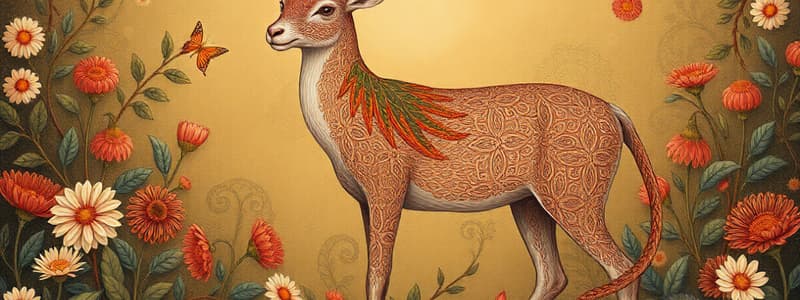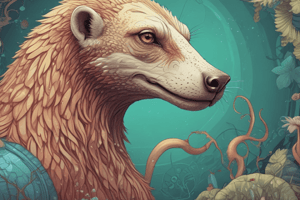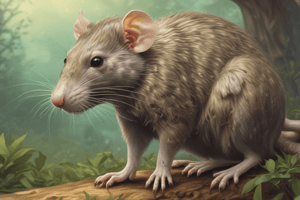Podcast
Questions and Answers
What is the scientific study of animals called?
What is the scientific study of animals called?
- Zoology (correct)
- Geology
- Botany
- Ecology
Which of the following is NOT a core aspect of zoology?
Which of the following is NOT a core aspect of zoology?
- Animal ecology
- Animal evolution
- Plant physiology (correct)
- Animal behavior
Who are some of the historical figures whose work contributed to the roots of zoology?
Who are some of the historical figures whose work contributed to the roots of zoology?
- Aristotle and Galen (correct)
- Plato and Socrates
- Newton and Einstein
- Darwin and Mendel
Which branch of zoology deals with the study of animal behavior in natural environments?
Which branch of zoology deals with the study of animal behavior in natural environments?
What does the term 'invertebrates' refer to?
What does the term 'invertebrates' refer to?
Which of the following is a key concept in zoology related to changes in populations over time?
Which of the following is a key concept in zoology related to changes in populations over time?
What is the study of the internal organization and structure of animals called?
What is the study of the internal organization and structure of animals called?
What is the study of prehistoric animal life through fossils called?
What is the study of prehistoric animal life through fossils called?
Which field of zoology focuses on the internal structure of animals?
Which field of zoology focuses on the internal structure of animals?
What does physiology primarily study?
What does physiology primarily study?
Which of the following describes the study of animal behavior?
Which of the following describes the study of animal behavior?
What does ecology primarily investigate?
What does ecology primarily investigate?
Which of these is the science of classifying and naming organisms?
Which of these is the science of classifying and naming organisms?
Which process explains how populations of organisms change over time?
Which process explains how populations of organisms change over time?
What field of study examines heredity and variation in organisms?
What field of study examines heredity and variation in organisms?
Which field uses fossils to study prehistoric life?
Which field uses fossils to study prehistoric life?
What does embryology study?
What does embryology study?
Which of the following describes the protection and management of biodiversity?
Which of the following describes the protection and management of biodiversity?
What is the transport of blood and nutrients in animal physiology called?
What is the transport of blood and nutrients in animal physiology called?
Which concept in ethology refers to innate behaviors that are genetically programmed?
Which concept in ethology refers to innate behaviors that are genetically programmed?
What is the term for the study of population size and dynamics in ecology?
What is the term for the study of population size and dynamics in ecology?
Which mechanism primarily drives evolution according to the text?
Which mechanism primarily drives evolution according to the text?
Which of the following is a key stage in animal development studied in embryology?
Which of the following is a key stage in animal development studied in embryology?
Flashcards
Zoology
Zoology
The scientific study of animals, including their anatomy, physiology, behavior, ecology, evolution, and conservation.
Morphology
Morphology
Deals with the study of the form and external structure of animals.
Anatomy
Anatomy
Focuses on the internal organization and structure of animals.
Physiology
Physiology
Signup and view all the flashcards
Ethology
Ethology
Signup and view all the flashcards
Ecology
Ecology
Signup and view all the flashcards
Taxonomy
Taxonomy
Signup and view all the flashcards
Evolution
Evolution
Signup and view all the flashcards
What is Anatomy?
What is Anatomy?
Signup and view all the flashcards
What is Comparative anatomy?
What is Comparative anatomy?
Signup and view all the flashcards
What is Physiology?
What is Physiology?
Signup and view all the flashcards
What is instinct?
What is instinct?
Signup and view all the flashcards
What is Learning?
What is Learning?
Signup and view all the flashcards
What is Social behavior?
What is Social behavior?
Signup and view all the flashcards
What is Communication?
What is Communication?
Signup and view all the flashcards
What are Mating systems?
What are Mating systems?
Signup and view all the flashcards
What is Ecology?
What is Ecology?
Signup and view all the flashcards
What is Population ecology?
What is Population ecology?
Signup and view all the flashcards
What is Community ecology?
What is Community ecology?
Signup and view all the flashcards
What is Ecosystem ecology?
What is Ecosystem ecology?
Signup and view all the flashcards
What is Taxonomy?
What is Taxonomy?
Signup and view all the flashcards
What is Evolution?
What is Evolution?
Signup and view all the flashcards
What is Genetics?
What is Genetics?
Signup and view all the flashcards
Study Notes
- Zoology is the scientific study of animals.
Core aspects of zoology
- It encompasses the study of animal anatomy, physiology, behavior, ecology, evolution, and conservation.
- Zoology aims to understand the diversity of animal life and the processes that shape it.
History and scope
- It emerged from natural history, with roots in the works of Aristotle and Galen.
- Modern zoology integrates knowledge from various disciplines, including molecular biology and genetics.
- The scope of zoology is vast, covering all aspects of animal life from the microscopic to the ecosystem level.
Major branches of zoology
- Morphology: Deals with the study of the form and structure of animals.
- Anatomy: Focuses on the internal organization and structure of animals.
- Physiology: Investigates the functions and processes of animal bodies, including organ systems.
- Ethology: Studies animal behavior in natural environments.
- Ecology: Examines the interactions between animals and their environment.
- Taxonomy: Deals with the classification and naming of animals.
- Evolution: Explores the evolutionary history and relationships of animals.
- Genetics: Studies the heredity and variation in animals.
- Paleontology: Focuses on the study of prehistoric animal life through fossils.
- Embryology: Examines the development of animals from fertilization to birth or hatching.
Animal classification
- Animals are classified into various groups based on their evolutionary relationships and shared characteristics.
- The major groups include invertebrates (animals without a backbone) and vertebrates (animals with a backbone).
- Invertebrates include a wide range of groups, such as sponges, cnidarians, mollusks, arthropods, and echinoderms.
- Vertebrates include fish, amphibians, reptiles, birds, and mammals.
Key concepts in zoology
- Evolution: The process by which populations of organisms change over time.
- Natural selection: The mechanism driving evolution, where individuals with advantageous traits are more likely to survive and reproduce.
- Adaptation: The process by which animals become better suited to their environment.
- Biodiversity: The variety of life in the world or in a particular habitat or ecosystem.
- Conservation: The protection and management of biodiversity and natural resources.
Morphology
- Morphology is the study of the form and structure of organisms, including animals.
- Gross morphology studies the overall shape and arrangement of body parts visible to the naked eye.
- Microscopic morphology includes histology (study of tissues) and cytology (study of cells).
Anatomy
- Anatomy is the branch of zoology focused on the internal structure and organization of animals.
- Comparative anatomy compares the anatomical structures of different animals to understand evolutionary relationships.
- Anatomical studies involve dissection, imaging techniques (such as X-rays and MRI), and computer modeling.
Physiology
- Physiology studies the functions and processes of animal bodies and their organ systems.
- Animal physiology examines how animals maintain homeostasis, respond to stimuli, and carry out essential functions.
- Key areas of study include:
- Respiration: The process of gas exchange.
- Circulation: The transport of blood and nutrients.
- Digestion: The breakdown and absorption of food.
- Excretion: The removal of waste products.
- Neural control: The function of the nervous system.
- Endocrine control: The function of hormones in regulating bodily functions.
Ethology
- Ethology is the scientific study of animal behavior, focusing on understanding the causes, functions, and evolution of behavior.
- Ethologists study animal behavior in natural settings, using observation and experimentation.
- Key concepts in ethology include:
- Instinct: Innate behaviors that are genetically programmed.
- Learning: Changes in behavior due to experience.
- Social behavior: Interactions between individuals within a population.
- Communication: The exchange of information between animals.
- Mating systems: The patterns of mate choice and parental care.
Ecology
- Ecology is the study of the interactions between organisms and their environment.
- Animal ecology examines how animals interact with each other and with their physical surroundings.
- Key areas of study include:
- Population ecology: The study of population size, density, and dynamics.
- Community ecology: The study of interactions between different species in a community.
- Ecosystem ecology: The study of the flow of energy and nutrients through an ecosystem.
- Animals play important roles in ecosystems as predators, prey, decomposers, and pollinators.
Taxonomy
- Taxonomy is the science of classifying and naming organisms.
- The taxonomic classification system is hierarchical, with organisms grouped into increasingly specific categories.
- The main taxonomic ranks are:
- Domain
- Kingdom
- Phylum
- Class
- Order
- Family
- Genus
- Species
- Animals are classified into the Kingdom Animalia, which is further divided into various phyla, classes, orders, families, genera, and species.
Evolution
- Evolution is the process by which populations of organisms change over time.
- Natural selection is the primary mechanism driving evolution, where individuals with advantageous traits are more likely to survive and reproduce.
- Evidence for evolution comes from:
- Fossil record
- Comparative anatomy
- Embryology
- Molecular biology
- Evolutionary relationships between animals are often depicted in phylogenetic trees, which show the branching patterns of descent from common ancestors.
Genetics
- Genetics is the study of heredity and variation in organisms
- Animal genetics examines how traits are inherited and how genetic variation contributes to evolutionary change.
- Key concepts in animal genetics include:
- Genes: Units of heredity that encode specific traits.
- Chromosomes: Structures containing DNA.
- DNA: The molecule that carries genetic information.
- Mutations: Changes in DNA sequence that can lead to variation.
- Genetic studies help to understand the causes of genetic diseases in animals and to develop strategies for genetic conservation.
Paleontology
- Paleontology is the study of prehistoric life, including animals, through the analysis of fossils.
- Animal paleontology examines the fossil record to understand the evolution and extinction of animal groups.
- Fossils provide evidence of past animal life, including their morphology, behavior, and ecology.
- Paleontological studies help to reconstruct the history of life on Earth and to understand the processes that have shaped animal diversity.
Embryology
- Embryology is the study of the development of animals from fertilization to birth or hatching.
- Animal embryology examines the processes of cell division, differentiation, and morphogenesis that give rise to the adult form.
- Key stages in animal development include:
- Fertilization: The fusion of egg and sperm to form a zygote.
- Cleavage: Rapid cell division.
- Gastrulation: The formation of the germ layers (ectoderm, mesoderm, and endoderm).
- Organogenesis: The formation of organs and tissues.
- Embryological studies provide insights into the evolutionary relationships between animals.
Conservation
- Conservation is the protection and management of biodiversity and natural resources.
- Animal conservation focuses on protecting endangered species, preserving habitats, and managing populations.
- Threats to animal biodiversity include:
- Habitat loss
- Pollution
- Climate change
- Overexploitation
- Invasive species
- Conservation efforts involve:
- Establishing protected areas
- Restoring habitats
- Managing populations
- Educating the public
- Zoologists play an important role in conservation by conducting research, monitoring populations, and advising policymakers.
Studying That Suits You
Use AI to generate personalized quizzes and flashcards to suit your learning preferences.




